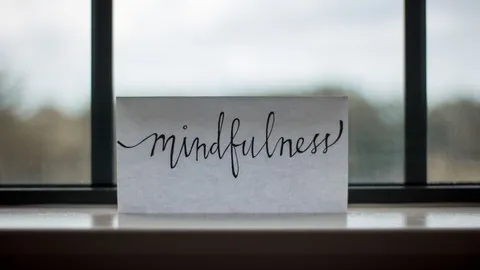
Mindfulness and Well-being: Peace in Peace Out 
This course introduces mindfulness as a tool for spiritual development, exploring its traditional roots and capacity to expand understanding of human consciousness. Through meditations, reflective exercises and activities, participants will gain practical application of the material to promote holistic well-being. ▼
ADVERTISEMENT
Course Feature
![]() Cost:
Cost:
Free
![]() Provider:
Provider:
Coursera
![]() Certificate:
Certificate:
Paid Certification
![]() Language:
Language:
English
![]() Start Date:
Start Date:
29th May, 2023
Course Overview
❗The content presented here is sourced directly from Coursera platform. For comprehensive course details, including enrollment information, simply click on the 'Go to class' link on our website.
Updated in [March 06th, 2023]
This course, Mindfulness and Well-being: Peace in Peace Out, is designed to introduce participants to the practice of mindfulness and its capacity to expand understanding about the nature of human consciousness. The course will explore the rich traditional roots of mindfulness and how it can facilitate certain transcendent emotional experiences, such as awe, wonder and flow. Through a variety of meditations, reflective exercises and activities, participants will gain a practical understanding of mindfulness and how it can be used to promote holistic well-being. This course is the culmination of a specialization created to help participants gain a deeper understanding of mindfulness and its potential to improve their overall well-being.
[Applications]
The application of this course is suggested to be used in everyday life. Participants are encouraged to practice the meditations, reflective exercises and activities learned in the course in order to gain a deeper understanding of mindfulness and its potential to promote holistic well-being. Additionally, participants are encouraged to share their experiences with others in order to help spread the knowledge and benefits of mindfulness.
[Career Paths]
1. Mindfulness Coach: Mindfulness coaches help individuals develop their own mindfulness practice and apply it to their daily lives. They provide guidance and support to help individuals become more mindful and aware of their thoughts, feelings, and behaviors. As the demand for mindfulness coaching increases, so does the need for qualified professionals to provide this service.
2. Mindfulness Educator: Mindfulness educators are responsible for teaching mindfulness to students in a variety of settings, such as schools, universities, and corporate settings. They create and deliver mindfulness-based curricula, lead mindfulness classes, and provide guidance and support to students. As the popularity of mindfulness continues to grow, so does the need for qualified educators to teach it.
3. Mindfulness Therapist: Mindfulness therapists use mindfulness-based interventions to help individuals manage stress, anxiety, depression, and other mental health issues. They provide individual and group therapy sessions, as well as workshops and seminars, to help individuals learn how to use mindfulness to improve their mental health. As the demand for mindfulness therapy increases, so does the need for qualified professionals to provide this service.
4. Mindfulness Researcher: Mindfulness researchers study the effects of mindfulness on physical and mental health, as well as its potential applications in various settings. They conduct research studies, analyze data, and publish their findings in academic journals. As the field of mindfulness research continues to grow, so does the need for qualified researchers to contribute to the field.
[Education Paths]
1. Bachelor of Science in Psychology: This degree path focuses on the study of the human mind and behavior, and provides a comprehensive understanding of the psychological processes that underlie mental health and well-being. It also covers topics such as cognitive development, social psychology, and research methods. With the increasing focus on mental health and well-being, this degree path is becoming increasingly popular and is a great way to gain the skills and knowledge needed to work in the field of mindfulness and well-being.
2. Master of Science in Counseling Psychology: This degree path focuses on the study of counseling and psychotherapy, and provides a comprehensive understanding of the psychological processes that underlie mental health and well-being. It also covers topics such as cognitive development, social psychology, and research methods. With the increasing focus on mental health and well-being, this degree path is becoming increasingly popular and is a great way to gain the skills and knowledge needed to work in the field of mindfulness and well-being.
3. Master of Science in Clinical Mental Health Counseling: This degree path focuses on the study of clinical mental health counseling, and provides a comprehensive understanding of the psychological processes that underlie mental health and well-being. It also covers topics such as cognitive development, social psychology, and research methods. With the increasing focus on mental health and well-being, this degree path is becoming increasingly popular and is a great way to gain the skills and knowledge needed to work in the field of mindfulness and well-being.
4. Doctor of Philosophy in Clinical Psychology: This degree path focuses on the study of clinical psychology, and provides a comprehensive understanding of the psychological processes that underlie mental health and well-being. It also covers topics such as cognitive development, social psychology, and research methods. With the increasing focus on mental health and well-being, this degree path is becoming increasingly popular and is a great way to gain the skills and knowledge needed to work in the field of mindfulness and well-being.
Pros & Cons

Knowledgeable instructor

Reduces stress, anxiety, and depression

Cultivates inner peace and compassion

Develops self awareness and improves relationships

Practical and inspirational

Lack of feedback

Failing grades without explanation
Course Provider

Provider Coursera's Stats at AZClass
Discussion and Reviews
0.0 (Based on 0 reviews)
Explore Similar Online Courses

Build a color tool in vanilla JavaScript

What Is Sociology? An Introduction - Online Course

Python for Informatics: Exploring Information

Social Network Analysis

Introduction to Systematic Review and Meta-Analysis

The Analytics Edge

DCO042 - Python For Informatics

Causal Diagrams: Draw Your Assumptions Before Your Conclusions

Whole genome sequencing of bacterial genomes - tools and applications

Mindfulness: What It Is Where It Comes From and How to Practice It

Free Meditation Tutorial - Mindfulness Meditation: The Science And Practice


Start your review of Mindfulness and Well-being: Peace in Peace Out